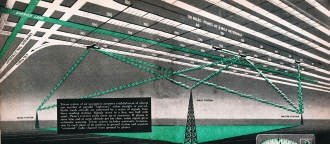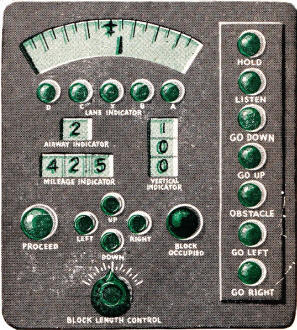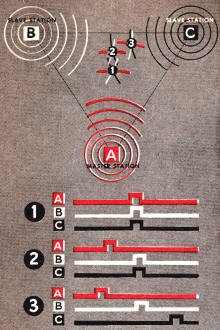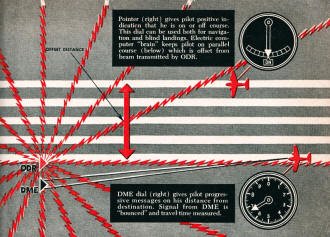|
March 1948 Popular Science
 [Table of Contents] [Table of Contents]
Wax nostalgic about and learn from the history of early
electronics. See articles from
Popular
Science, published 1872-2021. All copyrights hereby acknowledged.
|
For about a year before the
end of World War II, with the surrender of Germany in May 1945 and Japan in
September 1945, companies that had either voluntarily or forcibly converted their
efforts and facilities to the design and production of weapons and support equipment,
were running advertisements in magazines promising grand new products and services
for the civil sector based on knowledge gained from "mother," that is the entity
metaphorically credited for spurning invention. In many ways the promise was kept
through advances in radio, medicine, automation, materials science, recovering and
refining of raw materials, mass production, physics and chemistry, firearms, mathematics,
land, water, and air-based transportation, etc. Lots of war surplus hardware was
made available at huge discounts as a means of thanking the public for sacrifices
made during the war. This "Radio Builds Railroads in the Sky" article from a 1948
issue of Popular Science magazine reports on a system of aerial navigation
using a triangulation system, which derives from wartime methods.
Radio Builds Railroads in the Sky

Tricon system of air navigation proposes establishment of almost
any number of parallel "highways," either straight or curved. Radio roads actually
are patterned by a series of signals from three sending stations. Signals occur
in a line, one half mile apart. Plane's receiver picks them up in sequence. If planes
in same lane and at same altitude get too close, radar signal give automatic warning.
Tricon system includes automatic transmission by each plane of its position to ground
station and separate "command" radio channel from ground to planes.
By Devon Francis
Borrowing a barrelful of war-refined knowledge about radio and radar, U. S. scientists
have come up with a brace of systems for making transport flying as safe and systematic
as railroad operation.
One system is called TRICON (for TRIple COincidence Navigation). The other is
known as the B-D Computer Aerial Navigation System.
Both are designed to take the nightmare out of navigating an airplane from one
city to another when the weather closes down and even the birds start walking. The
B-D Computer system also has another feature: it can be adapted for actually landing
an airplane automatically with the aid of the federal government's experimental
Instrument Landing System (PS, March '46, p. 74).
The present inter-city navigation system, in use for a score of years, has worked
pretty well up to now. But the trouble with radio beams, or ranges as they are called,
is that in thick weather airplane schedules have to be slowed for safety's sake.
A beam provides only two lanes for traffic on any given airway.
The General Electric Co., for which Tricon was evolved, and the Minneapolis-Honeywell
Regulator Co., which developed the B-D Computer system, say this is nonsense, and
they present some answers.

Proposed cockpit instrument panel gives pilot
course deviation, airway number, lane identification, plane's altitude, mileage
flown. Buttons and lights let him examine occupancy of lanes above, below, and on
each side. Vertical lights at right are for commands from the ground.
Under either system, in the air space where only one airplane now flies in soupy
weather hundreds could fly in complete safety. Let's look at Tricon first. Ever
lose a favorite fishing rod over the side of the boat? After you got control of
your temper, you took a line of sight on a tree on shore, and then on another one
some distance from it, and calculated the angle between them.
You did this so you could locate the spot where the rod had disappeared when
you returned with a grapple. You oriented your-self. You "triangulated." Tricon
proposes to create a whole scad of superhighways for transport planes on every airway
in the United States with wholly automatic triangulation by radio.
Navigation by triangulation is nothing new. Transoceanic planes have used it
for years. War's Loran system (PS, Feb. '46, p. 78) was, in essence, a means of
locating an ocean vessel or plane by measuring angles and computing distances. What
makes Tricon interesting is the way its originator, Dr. Luis W. Alvarez, of the
University of California, proposes to do his triangulating.
As in Loran, he would use a "master" and a couple of "slave" radio sending stations.
Each leg of the triangle separating them would be many miles long. They would "scan"
a total distance of about 50 miles.
Families of these stations would be built at intervals along each heavily traveled
airway. For every half mile of travel, a pilot would be advised by an indicator
on his instrument panel whether he was where he was supposed to be. And this is
the way Dr. Alvarez says it would work:
Radio pulses travel at a fixed speed. That's about 1,000 feet each millionth
of a second. Now, supposing the "master" sending station and the co-ordinated "slaves"
emit signals at the same split second. Any receiving set equidistant from all three
stations would experience a simultaneous reception - the signals would come in by
TRIple COincidence.
Secret Is in Timing of Signals
But if timing of the signals was slightly off - if the slaves lagged behind the
master, for instance, by a millionth of a second - the point where their reception
coincided would be 1,000 feet away. The master's signal would have traveled 1,000
feet while the slaves were making up their minds to send.
That's how Tricon sets up superhighways in the sky. By giving the sending stations
a progressive change of pace, 500 times each second, 500 successive points at which
their signals are received in triple coincidence are established. By juggling the
order in which the three stations pulse in each one of those 500 separate cycles,
just that many triply coincident signal locations can be spotted along a given airway.
At none of them is the sending sequence of the three stations exactly the same.
So far, so good. Why 500 different sending combinations? Dr. Alvarez says the
figure is arbitrary. Each traffic highway would need 100 triply coincident signal
locations - one for each half mile of the 50-mile stretch being scanned. If there
were two outgoing and two incoming highways, that would mean 400 locations. That
extra hundred is a "barrier lane" separating opposing traffic, like the white line
on the motorist's highway.
That's only the start of Tricon, Now for the gimmick: the system has separate
command and control channels. In addition, each airplane using a Tricon airway would
be equipped with an automatic "annunciator" radio transmitter. After all, the folks
at selected intermediate stations on the ground want to keep track of the planes
in the air. They also want to give them orders. So the annunciators would keep sending
signals to the ground, and receiving equipment there would keep tab on every plane
aloft.

Heart of Tricon is pattern of signals from three
stations. In pattern 1, all stations pulse together, placing point of triple
coincident reception equidistant from transmitters. In patterns 2 and 3, pulses
lag, displacing points of simultaneous reception.
Identification, position, course, altitude, and speed would be automatically
recorded. This, in effect, would provide the counterpart of railroading's automatic
block signals. Every aircraft would get a flasher signal from traffic control on
the ground if it was getting too close to the tail of the plane in front of it,
another signal if the plane behind was getting too close to its tail.
It may sound like a third piece of pie after a turkey dinner, but the sponsors
of Tricon add that the whole system can be fed into the cockpit autopilot.
Tricon's shortcoming is not one of technical obstacles. Dr. Alvarez says it can
be done. What may hold up inauguration of the system or cause outright abandonment
of the idea is the expense of its installation.
The heavily traveled New York-Chicago direct airway is a case in point. Today
it is served by 17 radio-beam stations. Tricon would replace them with no less than
42 master-and-slave stations, plus a number of stand-by transmitters for use if
anything got out of kilter.
As yet, Tricon is only on the drafting board.
The other system for more accurate navigation, using Minneapolis-Honeywell's
B-D Computer, not only is far simpler, but it has a running start on Tricon. The
computer is in experimental use and has been recommended for adoption by the international
airline trade association, ICAO.
It is a combination of an electric brain and a bird dog. The brain figures out
the answers from all the variables - winds, distance, route, and aircraft speed
- and the dog points where to go. The B-D will not do everything Tricon proposes
to do. It won't keep ground stations posted as to the positions, courses, and altitudes
of planes in the air. It won't flash red lights if there is danger of collision.
But the company originating it says it will raise today's "one-lane country roads"
aloft to the status of 10-lane superhighways. Like Tricon, it will provide aircraft
with a large number of flight paths on any given airway. That means added safety.
Moreover it can be adapted to automatic landings.
B-D Computer operation requires three elements - the computer itself, a series
of omnidirectional radio beacon stations (ODR), and distance-measuring radio transmitters
(DME). ODR stations are now being set up by the government.

B-D (bearing-distance) computer navigation can
set up any number of parallel courses at any altitudes. At take-off plane proceeds
to pre-selected lane, then turns to fly straight-line course to vicinity of destination.
There it again changes course to arrive over airport. Pilot needs to set only three
dials on computer before take-off. Errors in resulting readings average less than
1%. The computer is the first instrument of its kind to be actually installed in
a plane and flown experimentally. Course offset allows for windage and other variables.
Can Set Up Hundreds of Airways
ODR differs from the conventional radio beam, emitting "A" and "N" Morse signals
to keep a plane on course, in that it sprays a direction-indicating signal out to
every point of the compass. Ordinary radio beams provide four airways, no more.
ODR could provide hundreds, if necessary. Its freely scattered signal could be only
confusing if it were not combined with a cockpit dial and needle pointing unerringly
at the transmitting station. A pilot needs only to tune in the proper frequency.
The needle says, "There's where you're going."
The needle gives him a line of position. He knows he is on the right road. What
he doesn't know is how far along the road he may have come since taking off. So
DME, issuing from a ground station too, is introduced. DME is only a variation of
war-time's Shoran (PS, Aug. '46, p. 128). DME tells a pilot how far he is from a
radio transmitting station. If he already knows he is on the right road, he has
all the information he needs.
The beauty of the B-D Computer is that a dispatcher at an airport can send large
numbers of airplanes separately down parallel lanes to the same destination. Planes
can fly "off course" and remain on course.
A pilot figures his winds, altitude, and the course he has been told to follow
before he enters his cockpit. These facts he feeds into the computer. If he is to
fly 15 miles off to one side of a straight line between take-off and destination,
he turns some knobs and loads the responsibility on the computer.
Then he feeds juice into the device. Instantly it begins digesting two signals
- one from ODR and the other from DME. One signal gives him the compass bearing,
the other the distance. A pilot can fly by watching the needle on his dial, manipulating
his controls to keep it centered, or if he likes he can feed the computer's answers
into the autopilot and sit back with the funny papers.
The plane will hold its track right up to its destination, turning from "off
course" to on course at the proper moment. The computer takes head winds, cross
winds, and tail winds in stride, and will switch from one ODR station to the next
automatically.
It can be made to do other tricks. It will work a dial giving a pilot his estimated
time of arrival at an airport. If he is advised in flight to slow down and come
in for a landing 25 minutes later to avoid "stacking," he can consult the computer
for the airspeed he should maintain to meet the new schedule. And, ODR, unlike the
radio-beam system now in use, isn't affected by static.
The B-D Computer system, too, supplies a third piece of pie on top of the turkey.
Just throw a switch. That feeds ILS (Instrument Landing System) signals into the
autopilot in place of the ODR signals, and the plane proceeds to land itself.
Posted April 4, 2024
|













